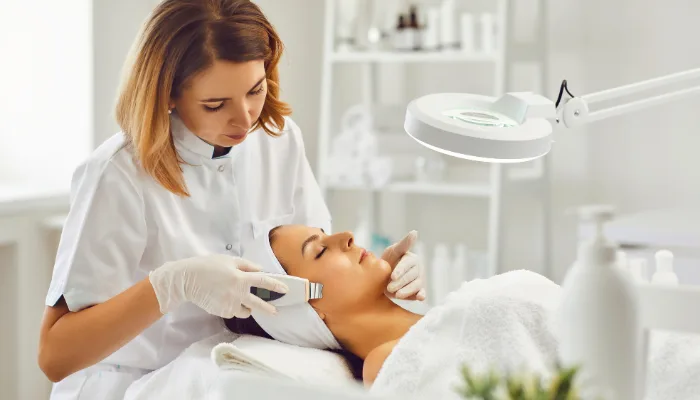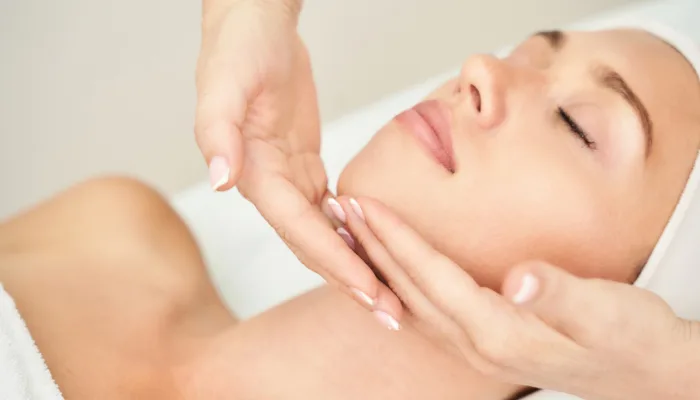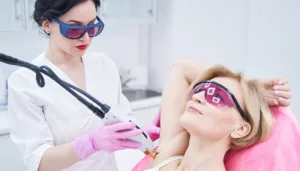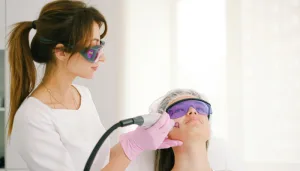
Aesthetic beauty courses are becoming increasingly popular as more people look to enter the world of beauty and skincare. But with so many options out there—from injectables to skin therapy—how do you know which path to choose?
In this article, we’ll break down everything you need to know about aesthetic beauty courses, from choosing the right one to exploring career opportunities and costs.
Key Takeaways
- Aesthetic beauty courses cover various treatments and techniques for skincare and beauty.
- Accreditation is vital; ensure your course is recognised by relevant authorities.
- When selecting a course, consider the provider’s reputation and the content offered.
- Career prospects in aesthetics are strong, with numerous roles available in the industry.
- Budgeting for tuition and exploring financial aid options can ease the cost burden.
Understanding Aesthetic Beauty Courses
Definition of Aesthetic Beauty Courses
Let’s start with the basics: what exactly are aesthetic beauty courses? Well, they’re basically educational programmes designed to give you the skills and knowledge to perform various cosmetic treatments. These courses cover everything from basic skincare to more advanced procedures like Botox and dermal fillers.
Think of them as your launchpad into a career focused on helping people look and feel their best. It’s not just about the treatments themselves, though; it’s also about understanding the science behind them, client consultation, and safety protocols.
Types of Aesthetic Beauty Courses
Okay, so you know what aesthetic beauty courses are in general, but did you know there’s a whole range of different types out there? It can be a bit overwhelming at first, but don’t worry, we’ll break it down. You’ve got your foundational courses, which are perfect if you’re just starting out. These usually cover things like:
- Basic skincare techniques
- Anatomy and physiology
- Hygiene and safety standards
Then, you’ve got more specialised courses that focus on specific treatments, such as:
- Dermal fillers
- Laser hair removal
- Chemical peels
And finally, there are advanced courses, like Level 7 qualifications, designed for experienced practitioners who want to take their skills to the next level. The options are pretty broad, so you can really tailor your education to match your career goals.
Importance of Accreditation
Right, let’s talk about something super important: accreditation. Basically, accreditation is like a stamp of approval that says a course meets certain quality standards. Why does this matter?
Well, for starters, it shows potential employers (or clients, if you’re planning to be self-employed) that you’ve received proper training from a reputable provider. Plus, some insurance companies will only cover practitioners who have completed accredited courses.
Choosing an accredited course can also give you peace of mind, knowing that the curriculum is up-to-date and relevant to industry standards. It might seem tempting to go for a cheaper, non-accredited course, but in the long run, it could end up costing you more in terms of career opportunities and professional credibility.
Choosing the Right Aesthetic Beauty Course
Choosing the right aesthetic beauty course can feel like a big decision, but it’s totally achievable if you break it down. There are loads of options out there, and it’s all about finding the one that fits your needs and career goals.
Factors to Consider
Think about what you actually want to get out of the course. Are you after a specific skill, like microblading or laser hair removal? Or are you looking for a more general foundation in aesthetics? Knowing your goals is half the battle.
Here’s a few things to think about:
- Your current skill level: Are you a complete beginner, or do you have some experience in beauty therapy?
- The course’s learning style: Do you prefer in-person learning, online modules, or a mix of both?
- The time commitment: Can you manage a full-time course, or do you need something more flexible?
- The course’s reputation: What do past students say about it?
Identifying Reputable Providers

You want to make sure you’re learning from a provider that knows their stuff and is going to give you a solid education. Look for providers that are accredited by recognised bodies. Accreditation basically means they’ve met certain standards of quality and are teaching to an industry-approved curriculum.
Also, check out the trainers’ backgrounds. Are they experienced practitioners themselves? Have they got a good track record? A good way to check is to see if they are registered with professional aesthetic bodies.
Understanding Course Content
Before you sign up for anything, make sure you know exactly what the course covers. Does it include the practical skills you need? Does it cover the relevant anatomy and physiology? What about health and safety regulations?
It’s worth asking for a detailed syllabus so you can see exactly what you’ll be learning each week. Don’t be afraid to ask questions – a good provider will be happy to answer them. If they’re vague or evasive, that’s a red flag.
Here’s a quick checklist:
- Anatomy and physiology
- Health and safety
- Practical skills training
- Client consultation techniques
- Aftercare advice
Career Opportunities in Aesthetics
What kind of jobs can you actually get afterwards? Let’s have a look at the possibilities.
Potential Job Roles
Okay, so you’ve got your qualification. What next? Well, the good news is that there are quite a few different roles you could go into. Here are a few ideas:
- Aesthetician: This is probably the most obvious one. Aestheticians provide a range of skincare treatments, from facials to more advanced procedures like laser hair removal and chemical peels. They work in salons, spas, or even have their own private practises.
- Medical Aesthetician: These guys work alongside doctors and nurses in clinics or hospitals, assisting with pre- and post-operative skincare for patients undergoing cosmetic surgery. It’s a bit more clinical, but it can be really rewarding.
- Laser Technician: If you’re into the techy side of things, you could specialise in laser treatments. This involves using lasers for hair removal, skin rejuvenation, and treating other skin conditions. You’ll need specific training for this, but it’s a growing field.
- Beauty Therapist: While beauty therapists offer a wider range of treatments, including things like waxing and massage, having an aesthetics qualification can really set you apart and allow you to offer more advanced skincare services.
- Salon or Spa Manager: With experience and the right skills, you could move into a management role, overseeing the day-to-day operations of a salon or spa. This involves managing staff, handling bookings, and ensuring clients are happy.
Advancement Opportunities
What about the future? The aesthetics industry is always evolving, so there are plenty of chances to learn new skills and move up the ladder.
- Specialisation: You could choose to specialise in a particular area, like anti-ageing treatments, acne treatments, or cosmetic injectables. This can make you more sought-after and allow you to charge higher prices.
- Further Education: Keep learning! Take advanced courses to expand your knowledge and skills. This could include things like learning about new technologies, mastering advanced techniques, or even getting a degree in a related field.
- Opening Your Own Business: Many aestheticians dream of opening their own salon or clinic. This gives you complete control over your career and allows you to build a business that reflects your own values and style. It’s hard work, but it can be incredibly rewarding.
- Training and Education: With enough experience, you could become a trainer yourself, teaching others the skills they need to succeed in the aesthetics industry. This is a great way to share your knowledge and help shape the future of the profession.
Industry Demand
Here’s the thing: people are always going to want to look and feel their best. That’s why the aesthetics industry is booming, and it’s not showing any signs of slowing down. The demand for skilled aestheticians is high, and it’s only going to increase in the coming years.
This means that if you’re willing to put in the work and get the right training, you’ll have plenty of opportunities to build a successful and rewarding career. Beginner aestheticians can earn around £30,000 a year, and this can increase as your portfolio grows.
Costs and Financial Considerations
Tuition Fees Overview
Aesthetic beauty courses, like most specialist training, can represent a significant investment. The fees can vary wildly depending on the course level (think Level 4 vs. Level 7), the provider’s reputation, and the equipment and materials included.
Generally, you’ll find that more comprehensive courses, especially those offering hands-on experience with advanced technologies, will command higher fees. But remember, cheaper isn’t always better; a too-good-to-be-true price tag might mean corners are being cut on quality and accreditation.
Budgeting for Your Course
Budgeting is your friend. Start by listing all the costs involved: tuition fees, obviously, but also consider travel expenses, accommodation if needed, textbooks or online resources, and any kit you might need to buy. Then, look at your income and outgoings.
Can you cut back on anything? Could you work extra hours?
Here’s a simple budgeting table to get you started:
| Expense | Estimated Cost (£) | Notes |
|---|---|---|
| Tuition Fees | [Insert Amount] | Check for payment plans |
| Travel | [Insert Amount] | Consider public transport or carpooling |
| Accommodation (if needed) | [Insert Amount] | Look for cheaper options like shared flats |
| Course Materials | [Insert Amount] | Can you buy used books? |
| Kit | [Insert Amount] | Prioritise essential items |
| Total | [Insert Amount] |
Remember to factor in some wiggle room for unexpected expenses. It’s always better to overestimate than underestimate.
Financial Aid Options
Now, for the good news: there are often ways to get help with funding your aesthetic beauty course. Many providers offer payment plans, allowing you to spread the cost over several months. Look into government-backed loans or grants – these can be a lifesaver.
Some charities and professional organisations also offer bursaries or scholarships for students pursuing further education in aesthetics. It’s worth doing your research and seeing what’s available. Don’t be afraid to contact the course provider directly and ask about financial aid options; they might have partnerships with lenders or internal schemes you’re not aware of.
Here are a few potential avenues to explore:
- Professional and Career Development Loans
- Advanced Learner Loans (if eligible)
- Training provider payment plans
- Industry-specific scholarships and bursaries
Practical Training and Experience
Importance of Hands-On Training
Okay, so you’ve got the theory down. Anatomy? Check. Different skin types? Check. But honestly, reading about it is nothing like actually doing it. Hands-on training is where the magic happens. You need to feel the products, understand the pressure, and see how real skin reacts.
Courses that skimp on this are a massive red flag. You wouldn’t want to learn to drive a car just by reading the manual, would you? Same principle applies here. You need to practise on real people, not just mannequins, to truly get the hang of things.
Internship Opportunities
Landing an internship after your aesthetic beauty course can be a game-changer. It’s your chance to put everything you’ve learned into practise in a real-world setting. Think of it as a bridge between the classroom and your future career.
Look for courses that have links with clinics or salons, or even better, those that offer placements as part of the course. It’s also worth checking if your course provider has a job board.
Building a Portfolio
Your portfolio is basically your aesthetic CV. It shows potential employers (or clients, if you go freelance) what you can do. Make sure you document everything you do during your training. Before-and-after photos are gold, so get consent from your models and take clear, well-lit pictures. Include a variety of treatments to show your range of skills. And don’t forget to get testimonials from people you’ve worked on – a few kind words can go a long way.
Building a solid portfolio takes time and effort, but it’s an investment in your future. It’s what will set you apart from the competition and help you land your dream job. So, start collecting those photos and testimonials now!
Regulatory Standards and Compliance
Understanding UK Regulations
Navigating the regulatory landscape in the UK for aesthetic beauty is super important. It can feel like a maze, but understanding the rules is key to running a safe and successful practise.
Currently, there isn’t a single, all-encompassing law that covers every aspect of aesthetics, which can make things a bit tricky. However, several regulations and guidelines impact the industry, and it’s your responsibility to know them.
- The Local Government Act 2003 gives local councils the power to require licences for certain treatments, like laser hair removal.
- The Health and Safety at Work etc. Act 1974 ensures a safe working environment for both practitioners and clients.
- The Medicines and Healthcare products Regulatory Agency (MHRA) regulates medical devices, including dermal fillers.
Staying updated with these regulations is not just about ticking boxes; it’s about ensuring client safety and building trust. It’s a good idea to regularly check for updates from regulatory bodies and consider joining professional associations that provide guidance and support.
Importance of Compliance
Compliance isn’t just a legal requirement; it’s the bedrock of a trustworthy and thriving aesthetic practise. By adhering to regulatory standards, you’re demonstrating a commitment to client safety and ethical practise.
Think of it this way: compliance builds confidence. Clients are more likely to trust practitioners who are clearly operating within the bounds of the law and industry best practises.
Here’s why compliance matters:
- Client Safety: Regulations are in place to protect clients from harm. Compliance minimises the risk of adverse effects and ensures treatments are performed safely.
- Reputation: A good reputation is everything in this industry. Compliance helps you build and maintain a positive image, attracting more clients and referrals.
- Insurance: Many insurance providers require practitioners to be compliant with regulations to obtain coverage. This protects you financially in case of any unforeseen incidents.
Consequences of Non-Compliance
Ignoring regulatory standards can lead to some pretty serious consequences. It’s not just about getting a slap on the wrist; non-compliance can have a significant impact on your career and business.
Here’s what you could face:
- Fines and Legal Action: Regulatory bodies have the power to issue fines and take legal action against practitioners who violate regulations. This can be costly and damaging to your reputation.
- Business Closure: In severe cases of non-compliance, regulatory bodies can order the closure of your business. This can be devastating, especially if you’ve invested a lot of time and money into your practise.
- Loss of Professional Licences: If you’re a registered healthcare professional, such as a nurse or doctor, non-compliance can lead to the suspension or revocation of your professional licence. This can effectively end your career in aesthetics.
Future Trends in Aesthetic Beauty Education
Emerging Technologies
In aesthetic beauty education, we’re seeing loads of new tech creeping in. Think augmented reality for training – imagine practising injectables on a virtual face before you even touch a real person! Also, there’s AI. It’s being used to personalise learning, so you get a course that’s tailored just for you.
Online Learning Opportunities
Online learning? It’s not just a fad; it’s here to stay. And it’s getting better. We’re talking interactive webinars, virtual reality training modules, and online communities where you can chat with other students and instructors.
The flexibility is a massive plus, especially if you’re juggling work or family commitments. Plus, you can access courses from anywhere in the world. I mean, who wouldn’t want to learn from a top expert without having to move?
Industry Innovations
The aesthetic beauty industry is always coming up with new treatments and techniques. And that means education has to keep up. Courses are now including stuff like regenerative aesthetics (using your body’s own cells to rejuvenate skin) and advanced skincare technologies.
It’s all about staying ahead of the curve and offering clients the latest and greatest. Plus, there’s a growing focus on sustainability and ethical practises, which is great to see.
It’s important to remember that while new technologies and treatments emerge, the core principles of safety, ethics, and client care remain paramount. Future education will likely emphasise these aspects even more, ensuring practitioners are not only skilled but also responsible.
Conclusion
Pursuing a course in aesthetics can be a transformative step for anyone looking to enter or advance in the beauty industry. With the right training, you can develop the skills needed to excel in this growing field. Remember to choose accredited courses that offer comprehensive training and practical experience.
This will not only enhance your knowledge but also boost your confidence as you start your career. Take the leap, enroll now and invest in your future in aesthetics. Your journey towards a fulfilling career in beauty starts now!
Frequently Asked Questions
What are aesthetic beauty courses?
Aesthetic beauty courses teach people about beauty treatments and skincare. They cover things like how to do facials, use makeup, and perform cosmetic procedures.
Do I need to be a qualified beauty therapist to take these courses?
Not always! Some courses are for beginners, while others might require you to have some background in beauty or healthcare.
How long do aesthetic beauty courses usually take?
The length of the courses can vary. Some might only last a few days, while others can take several weeks or months to complete.
Are these courses accredited?
It’s important to choose accredited courses. Accreditation means that the course meets certain standards and is recognised in the industry.
What job opportunities can I get after completing an aesthetic beauty course?
After finishing an aesthetic course, you can work as a beauty therapist, aesthetic practitioner, or even start your own beauty business.
How much do aesthetic beauty courses cost?
The cost can differ widely depending on the course and provider. It’s best to check different schools to find one that fits your budget.







